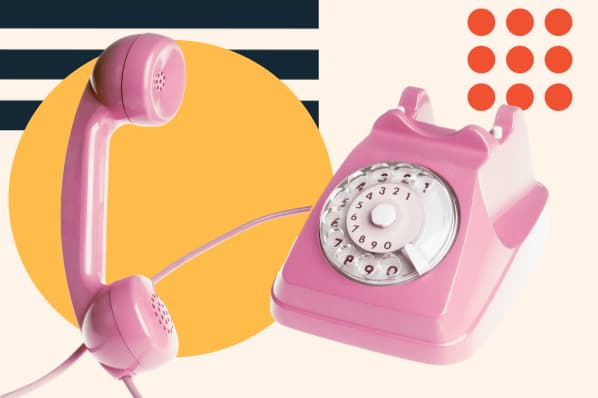I've written more sales close plans than I can count, and all of them start the same way: using my proven sales close plan template.
Sales close plans are critical for winning high-value accounts and finally converting customers you've been talking to for months. Once you invest that much energy into pitching your product, the last thing you want is to flush the deal down the drain with a poorly prepared sales closing process.
In this post, I‘m going to walk you through my proven process of creating a sales close plan that’s helped me get thousands of deals across the finish line. But first up: What is a sales close plan?
Table of Contents
- What Is a Sales Close Plan?
- Sales Close Plan Checklist
- How to Create a Sales Close Plan
- Sales Close Plan Template
- When to Create a Sales Close Plan
Free Download: Sales Plan Template
What Is a Sales Close Plan?
A sales close plan (also known as a deal plan) is a document that includes action items, outlines follow-up steps, answers questions, and resolves potential roadblocks with the intent to win a deal. Sales close plans are designed to clear up any last-minute points of confusion and set up post-purchase steps.
I'm a big believer in preparation, so I always create a sales close plan for my prospect. It always increases my chances of winning the deal and prepares me for any last-minute objections.
The sales close plan should cover whatever your prospect suggests but will generally encompass the remainder of the sales cycle, how to sell the product internally, and the implementation of the product.
The result? Improved organization, sales efficiency, and prospect experience.

Free Sales Plan Template
Outline your company's sales strategy in one simple, coherent sales plan.
- Target Market
- Prospecting Strategy
- Budget
- Goals
Download Free
All fields are required.

Why You Should Create a Sales Close Plan
Setting up a formal sales close plan ensures you and your prospect — and anyone else associated with the purchase decision — are on the same page. You can think of it as a mutual action plan for your prospective buyer that will guide them through the final stages of the sales process.
It also makes the sales process more manageable for a prospect who's never gone through a major purchase decision before by taking a gargantuan task and breaking it up into little, achievable pieces.
Potential obstacles: In most sales situations, the biggest challenge is inertia. Whether it‘s moving a prospect off a legacy product or introducing a new type of product for the first time, it’s usually easier for prospects to do nothing than to enter into a potentially complicated purchase or implementation.
Not only does a sales close plan remove this hesitation to act, but it also helps accelerate the deal and decision-making. Once the prospect has invested time in creating a plan, they have more incentive to move forward so their work doesn't go to waste.
Creating a sales close plan does two main things:
- Demonstrates your understanding of the problem at hand, and
- Provides an opportunity to clear up problem areas.
By clearly defining how to proceed through the sales process and implementation, you‘re reaffirming that your solution is actually solving a problem and that you’re speaking with the right people.
Pro tip: It‘s important to keep goals front of mind, both for you and your prospect. Emphasize the solution’s value throughout, not the product's specific features.
How to Create a Sales Close Plan
A good deal plan can be a complex or a very basic document. Below are the steps I take when creating a deal plan to make sure I'm covering all the bases.
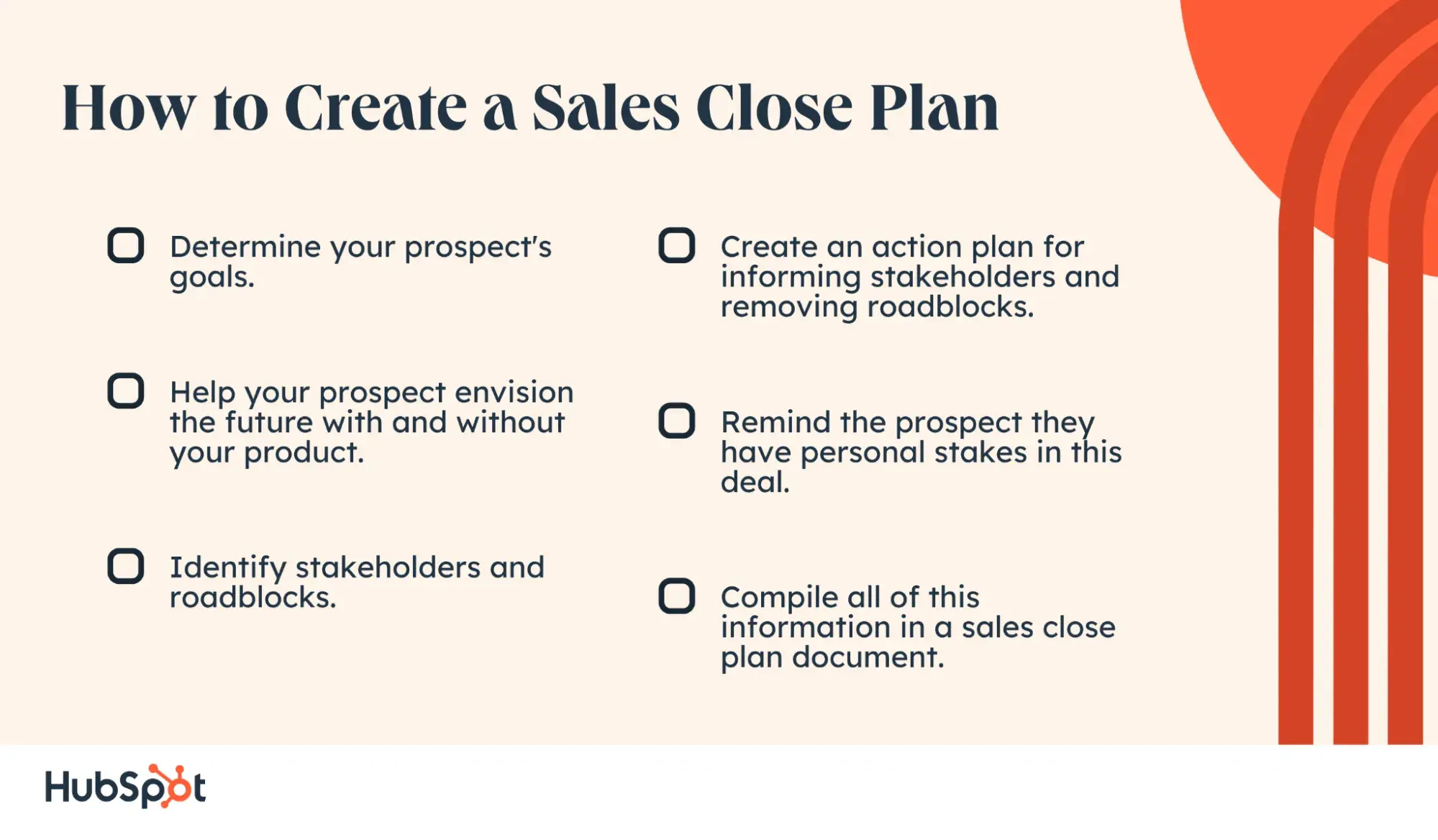
1. Determine your prospect's goals.
You might have already gotten a good idea of your prospect's goals during your discovery call and follow-up conversations. But it‘s always a good idea to brush up on their goals once again when you’re creating your sales close plan.
Their priorities might have shifted during your conversations, especially if you surfaced an issue that they may not have previously accounted for. Here are a few questions you should ask:
What are your goals?
People who don‘t have goals aren’t good customers. Your job as a sales rep is to find great prospects who will become great clients, which will reduce churn.
What's your why?
Prospects don't buy for rational reasons — they buy for emotional reasons. Your product is a rational means to an end, but that end is usually influenced by emotion. Your prospect has an image of the future in their head, and your product can help them get there.
Pro tip: Prompting a prospect to talk about that future helps them understand why they should invest time and money in your solution.
If you don't know the answers to these questions, do you know whom to ask to find out?
Hopefully, they'll know the answers. But if not, they should be able to tell you who has the relevant information.
2. Help your prospect envision the future with and without your product.
Your prospect won't close with you unless you help them see what their life (or job) will be like after they close with you.
Write this down: I recommend asking the following simple question — “What changes will result from this purchase?”
Without sounding sales-y, this question helps my prospect to look ahead and explore these questions:
- If I sell them my product and they use it successfully, what fundamental changes will they need to make to their business?
- Will they need to add headcount?
- Set up regular training sessions?
- Reallocate budget?
But don't just focus on the logistics. Help them see the positive changes, too, such as growth opportunities and increased revenue. Only after you paint this image should you move on to process- or logistics-related conversations.
Another question I like to ask is: “What happens if you don't complete this purchase?”
With this question, you can find out your prospect‘s Plan B. They might be in a difficult situation if they don’t make this purchase, and asking them to envision that possibility will kickstart the closing process.
Extra insight: This question can reveal that you‘re in a competitive situation, in which case it’s time to reach out to a coach or champion and figure out where you stand.
3. Identify stakeholders and roadblocks.
After you‘ve painted an image of your prospect’s future with and without your product, it's time to clear up some logistical information, such as who has the final word on the purchase and who has buy-in.
Opportunity to clarify: You might‘ve uncovered this information at the beginning of your conversations with your prospects, but these answers often change after you’ve established enough trust and rapport. When they first started speaking with you, they might've provided vague answers, and your close plan is your opportunity to clarify.
Here are two questions you might ask:
Who's responsible for buy-in?
This depends on who will be using your product and how it will be implemented. It's also important to consider whether an executive needs to sign off on a decision.
And don‘t forget about potential detractors. For example, if a stakeholder previously acted as a champion for one of your competitors, it’s important to bring them into the fold early. Identify that person and have a conversation about how to save face and smooth the transition — you don't want to make an enemy.
What are your biggest challenges to the purchase?
Identify the roadblocks to purchase as soon as possible. This question will help you understand what still needs to be done before your prospect signs on the dotted line.
Other questions you might ask include:
- Who needs to be involved in the actual purchase — signing contracts, approving budgets, etc.?
- Does the purchase require an RFI (request for information), an RFQ (request for quotation), or any other documentation you'll be responsible for coordinating?
- Does Legal need to get involved?
- If additional documentation or reviews are needed, how long will those processes take?

Free Sales Plan Template
Outline your company's sales strategy in one simple, coherent sales plan.
- Target Market
- Prospecting Strategy
- Budget
- Goals
Download Free
All fields are required.

4. Create an action plan for informing stakeholders and removing roadblocks.
Once you‘ve gotten answers to the questions outlined in the previous section, it’s time to create an action plan to inform stakeholders, address any concerns, and draft any necessary documents.
For instance, if your prospect indicates that they need to create a RFQ or RFP, then your next step might be to draft the quote or proposal and send it back to your prospect (even before they send you a formal RFQ or RFP). If your prospect needs to inform certain parties about the upcoming purchase decision, then you should outline meeting dates, especially if you plan to be in attendance.
Pro tip: Remember that the sales close plan is a collaborative document that both of you are working on to successfully close the deal. Since you're the salesperson, you might be more driven to close, but success is a goal for both of you, and the action plan should reflect this.
This collaborative approach is what makes a sales close plan such a powerful tool. Do this right, and you'll set yourself up for a healthy, productive, long-term relationship with this client.
5. Remind the prospect they have personal stakes in this deal.
When aiming for the close, it‘s all too easy to look at the deal from an overarching perspective, i.e. “My company will help your company achieve [x].” But when it’s near the end of the sales cycle, it's critical to zoom back in.
You are one person speaking to another, and if your prospect doesn‘t buy your product, their company doesn’t lose; they do. A way to reframe your sales close plan is to think of it as a mutual success plan for both you and your prospect.
That's why I like to ask prospects — “What's your personal goal?”
I always want to know whether my prospect has skin in the game. This gives me a sense of which motivating levers I can pull to move the deal ahead and forces the prospect to revisit exactly why this deal is important to them.
The closer you get to the end of a sales cycle, the higher the chance that your prospect will be fatigued. Refocusing them on the prize is crucial. Setting up your close plan as a joint execution plan can help reframe it for prospects.
6. Compile all of this information in a sales close plan document.
Whether you use a spreadsheet, a Word document, or a PowerPoint presentation, it's important to compile all of your findings in a sales close plan document. You can usually adjust your existing company sales plan to create your close plan, and remember to share it with your prospect so that they can make adjustments and leave comments as needed.
The good news: You don't have to make a successful sales close plan document from scratch. I use the template below every time I need to create a close plan, removing and adding sections when needed. Sales leaders can customize this plan for their sales teams to create a clear roadmap to closing.
Sales Close Plan Template
Featured Resource: Sales Close Plan Template
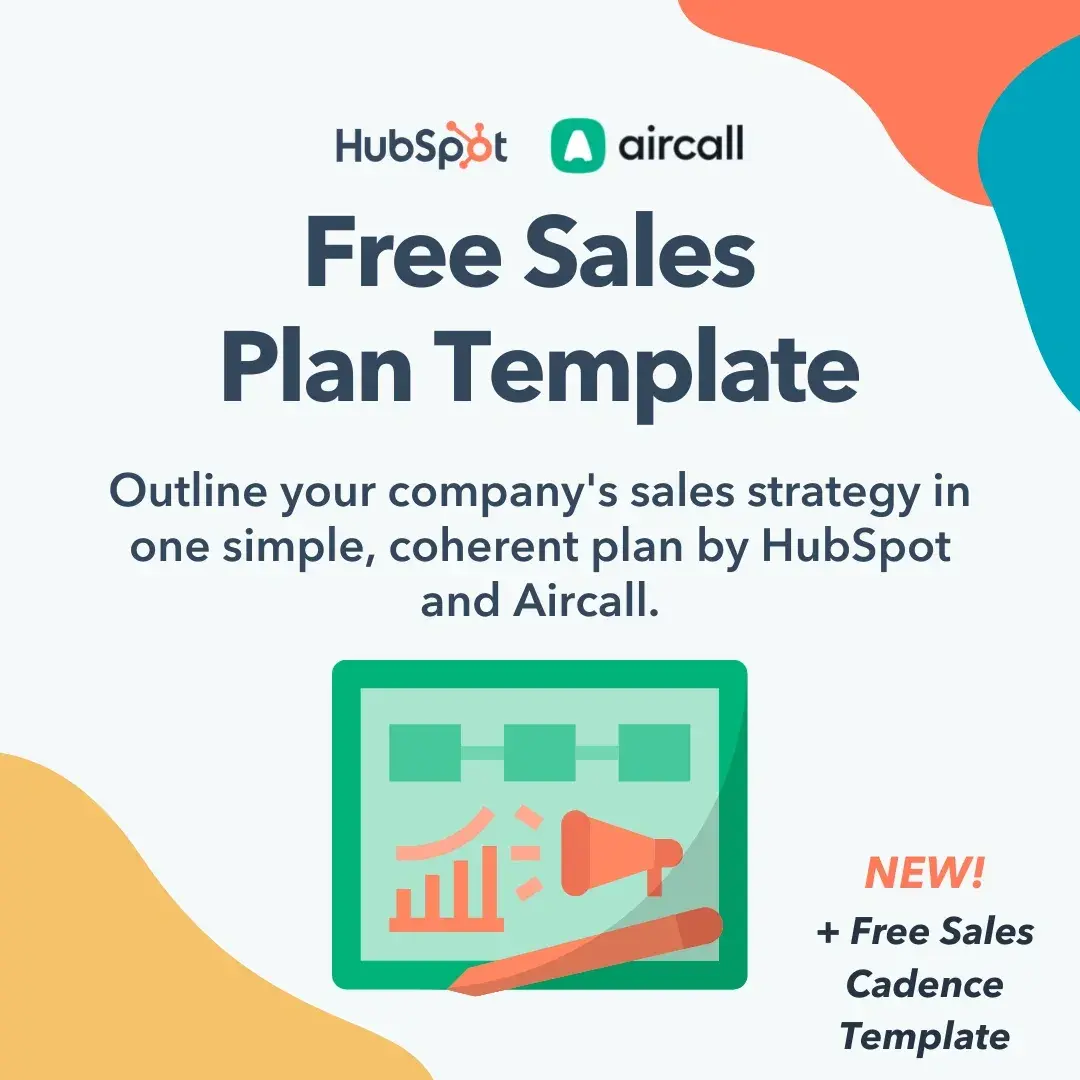
This free template includes all the sections you need to create a foolproof close plan with your prospect. You have two options:
- A plain-text document, or
- A designed one that includes images and graphics.
Depending on your industry, you might benefit from going the text-only route.
Our free sales plan template includes both text and design options within one ready-to-customize document:
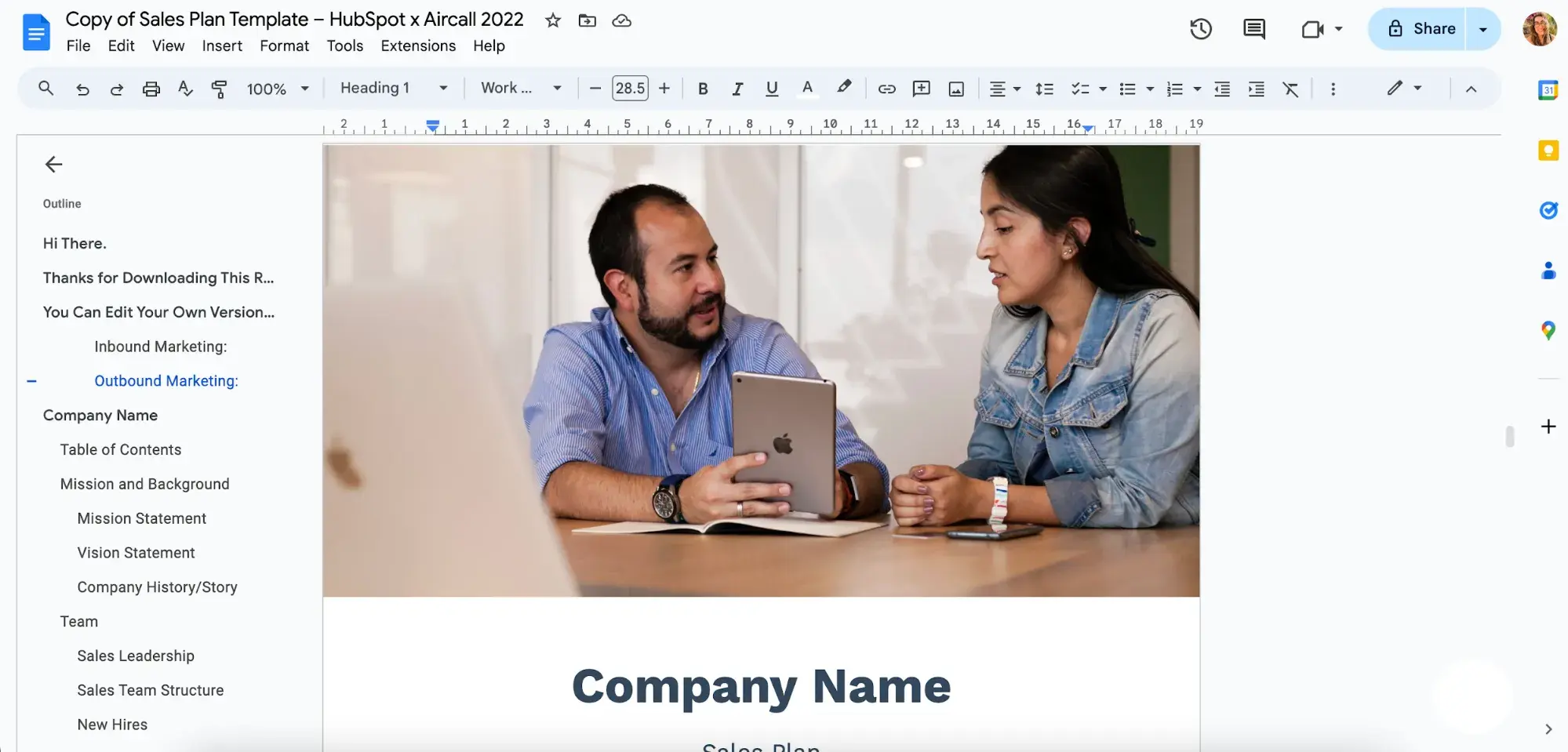
Pro tip: You can also use this template to create a company-wide sales plan that will enable your entire sales team to sell more effectively, reach revenue goals, and use the resources available to them.
Here are the sections I suggest you include in your sales close plan:
- Cover Page. Introduce the company you‘ll be creating the sales close plan with. Don’t forget to include your prospect's name under “Written by” or “Authors.”
- Mission (optional). Include your prospect‘s mission if you feel it will help with the close. Understanding your prospect’s goal from an overarching standpoint can help you make that final pitch more effectively.
- Team. I'd recommend listing stakeholders in this section, paying special attention to decision-makers.
- Target Market. Outline your prospect's target market here. Compile all of your notes from your discovery call to populate this section.
- Tools, Software, & Resources (Optional). It might be helpful to know which tools your customer is already using. Are they using a competitor? Do they normally buy the type of product you sell? Change your pitch accordingly.
- Positioning. This is a critical section that will help you understand your prospect‘s standing in their industry. Fill it in with their help. Guessing won’t do you any favors here.
- Marketing Strategy (Optional). This section is optional unless you sell a marketing product. If you do, it's important to understand how your prospect currently markets their products and services.
- Prospecting Strategy (optional). Your buyer‘s prospecting strategy isn’t necessary unless you sell a product that can help them prospect more effectively — say, sales software.
- Action Plan. This is where you'll list what you and your prospect need to do to close the deal and successfully onboard them.
- Business Goals. List your prospect's revenue and other quantitative goals. Any qualitative goals, such as “Streamline operations,” should also be listed here.
- Budget. Include a brief outline of your potential client's budget for this purchase.
Don't start from scratch — use our free template below and get guided through the customization step by step.
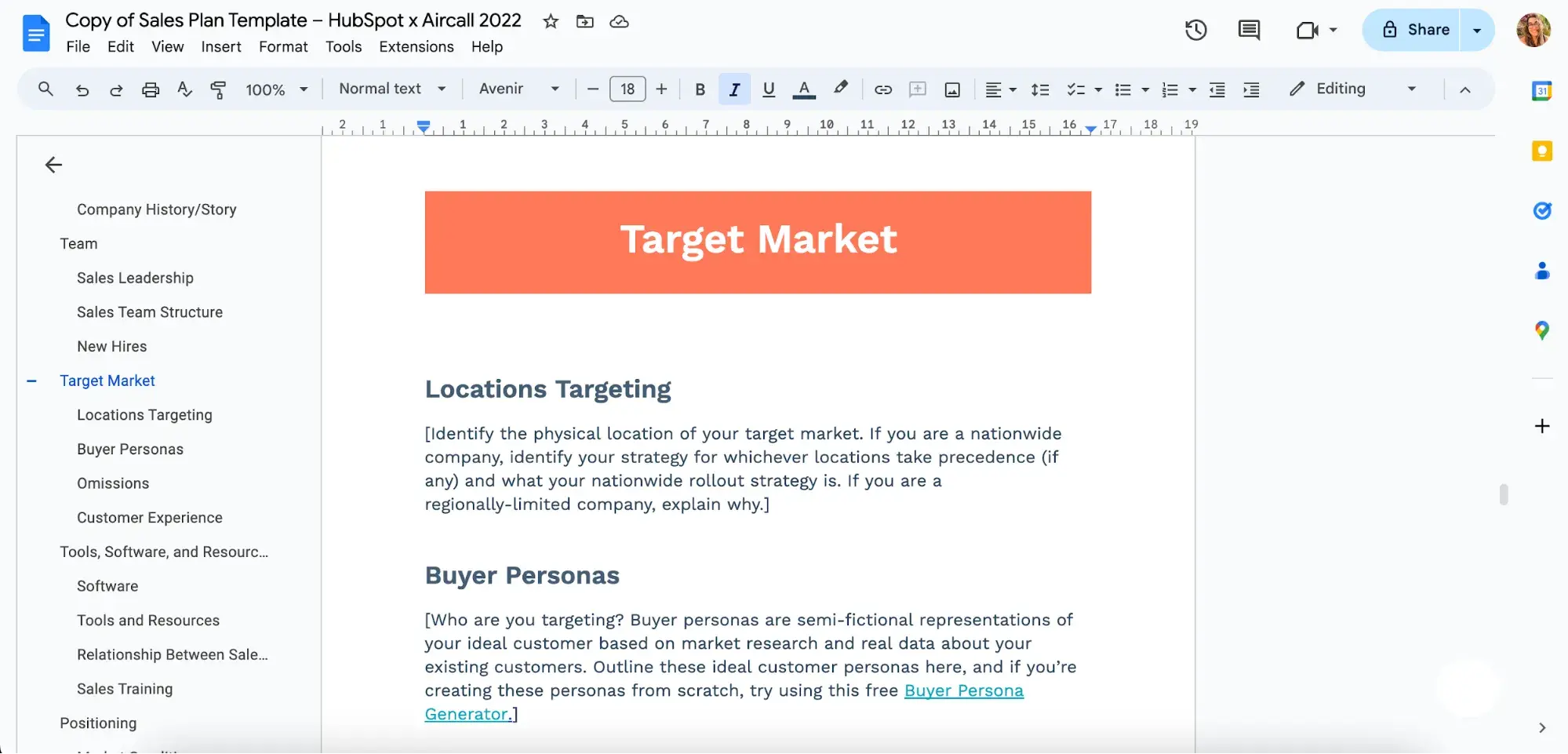
Sales Close Plan Checklist
- Know your prospect’s goals inside and out. Create a private bulleted list if needed, and ask as many questions as you need to.
- Define the purchasing process. Know who needs to be involved and what documents your prospect needs you to deliver.
- Know your prospect’s budget. Your sales close plan won’t be complete without it.
- Get buy-in from stakeholders. This ensures everyone is on the same page.
- Ask the prospect to review your close plan. Formally present it if you need to and ask how you can help them get buy-in.
- Answer the naysayers. Go straight to your blockers with the plan to air out all their objections.
- Adjust the sales close plan as you move closer to the end. It’s a living, breathing document that should help you refine your closing pitch.
When to Create a Sales Close Plan
Ideally, you’ll want to start discussing a sales close plan during the discovery phase of the sales process. Yes, closing starts at your first call! Not only will you be outlining what the plan contains, you'll also be determining its scope.
I always ask, “Have you bought a similar product before?” In HubSpot's case, I check for previous purchases of enterprise software.
This question is crucial. Here's why:
- If this is the first time they‘ve ever bought something like your offering, your plan needs to outline how to buy in the first place. You’ll need to walk them through how to get internal buy-in and how to evaluate if your product is a good solution, working closely with them throughout.
- If, however, your prospect is familiar with buying your type of product, your sales close plan might not need to cover the purchase at all. They know whom to speak with internally and how to get a deal over the finish line. They need your expertise in implementation, and that's what your plan should focus on.
This information will make your sales strategy more tailored to your prospect's unique position.
Pro tip: Learn what other questions you should be asking in our buyers' journey question guide.
Sales close plans are also useful if you get stuck somewhere in the sales cycle. Sometimes, you'll speak with a prospect who needs your product but is avoiding you or artificially elongating the process. A sales close plan can help define the process, especially if you suspect the problem is a lack of executive buy-in.
Overarching benefit: A sales close plan can streamline your closing process, especially with high-value prospects you don‘t want to lose. By creating one, you’ll strengthen your sales process at its most critical point and exponentially increase the chances of a closed-won deal.
Why a Sales Close Plan Matter
After many years working in sales, I've learned that every deal is different — but this close plan foundation is always the same. The entire sales process comes down to this moment. My free template is a great starting point for you or your sales reps to end the buying process on an organized, efficient, high note.
Having a structured approach to closing will not only help sales teams close deals — it‘ll keep your prospects happy, too. Having an organized approach to closing saves time, keeps everyone on the same page, and keeps leads from falling through the cracks. It’s the first step towards customer success.
Editor's note: This post was originally published in January 2018 and has been updated for comprehensiveness.

Free Sales Plan Template
Outline your company's sales strategy in one simple, coherent sales plan.
- Target Market
- Prospecting Strategy
- Budget
- Goals
Download Free
All fields are required.

Sales Closing






![How Close Rates are Shifting in 2024 [New Data]](https://53.fs1.hubspotusercontent-na1.net/hubfs/53/close-rate.webp)
![Sales Pros Say This Tool is Key to Driving Sales: How to Close More Deals With It [Data]](https://53.fs1.hubspotusercontent-na1.net/hubfs/53/85_Best-Sales-Strategies.png)



